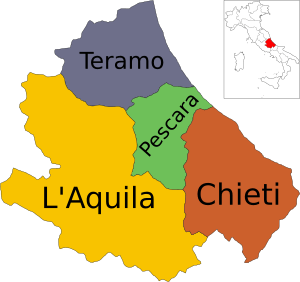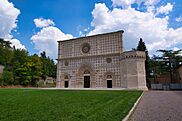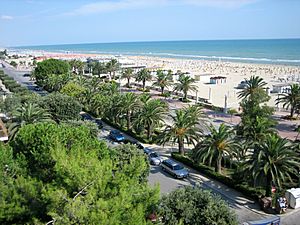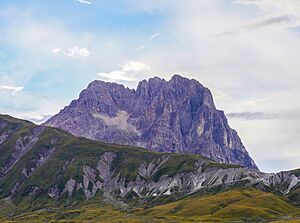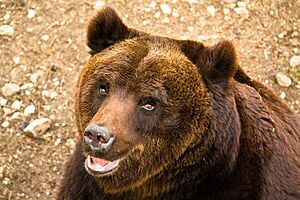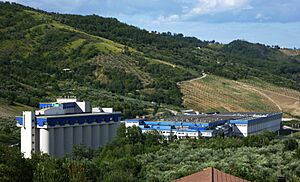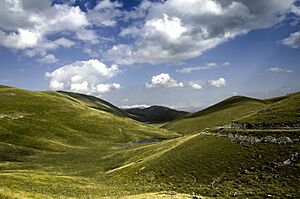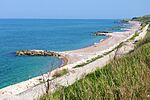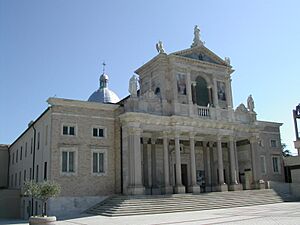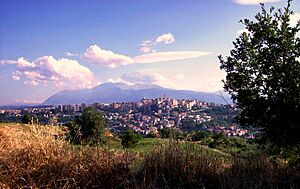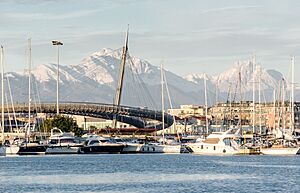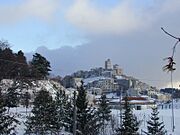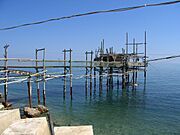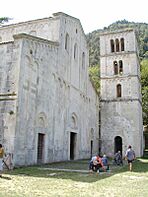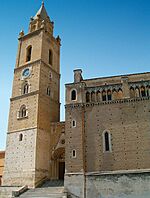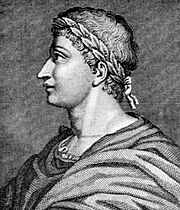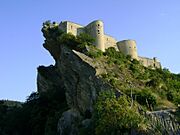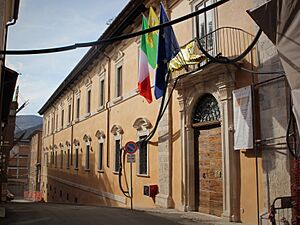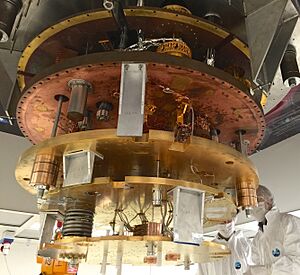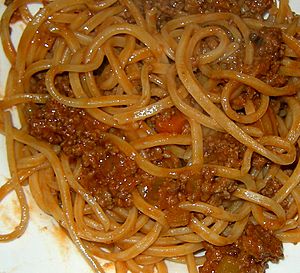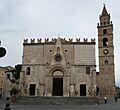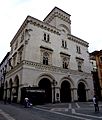Abruzzo facts for kids
Quick facts for kids
Abruzzo
Abbrùzzu / Abbrùzze (Neapolitan)
Abruzzi
|
|||
|---|---|---|---|
|
|||
 |
|||
| Country | |||
| Capital | L'Aquila | ||
| Largest city | Pescara | ||
| Area | |||
| • Total | 10,763 km2 (4,156 sq mi) | ||
| Highest elevation | 2,914 m (9,560 ft) | ||
| Population
(2020)
|
|||
| • Total | 1,305,770 | ||
| • Density | 121.320/km2 (314.218/sq mi) | ||
| Demonym(s) | Italian: Abruzzese | ||
| GDP | |||
| • Total | €32.889 billion (2021) | ||
| Time zone | UTC+1 (CET) | ||
| • Summer (DST) | UTC+2 (CEST) | ||
| ISO 3166 code | IT-65 | ||
| HDI (2021) | 0.892 very high · 13th of 21 |
||
| NUTS Region | ITF | ||
| Website | https://www.regione.abruzzo.it/ | ||
Abruzzo is a beautiful region in Southern Italy. It covers about 10,763 square kilometers (4,156 sq mi) and is home to around 1.3 million people. Abruzzo is split into four areas called provinces: L'Aquila, Teramo, Pescara, and Chieti.
This region is special because it has both tall mountains, like the Gran Sasso d'Italia and the Maiella, and lovely beaches along the Adriatic Sea. It's often called "the greenest region in Europe" because almost half of its land is protected by national parks and nature reserves. These parks help rare animals like the golden eagle, the Abruzzo chamois, the Apennine wolf, and the Marsican brown bear to survive.
A famous Italian writer once described Abruzzo and its people as "forte e gentile" (strong and kind). This saying has become the region's motto.
Contents
Provinces and Government
Provinces of Abruzzo
Abruzzo is divided into four main areas, each with its own capital city:
| Province | Area (km2) | Population | Density (people/km2) | Capital City | Number of Towns |
|---|---|---|---|---|---|
| Chieti | 2,588 | 396,190 | 153.1 | Chieti | 104 |
| L'Aquila | 5,034 | 308,876 | 61.3 | L'Aquila | 108 |
| Pescara | 1,225 | 318,701 | 260.1 | Pescara | 46 |
| Teramo | 1,948 | 308,769 | 158.5 | Teramo | 47 |
How Abruzzo is Governed
The government of Abruzzo is a representative democracy. This means people vote for leaders to represent them. The main leader is the President of the Regional Government, who is elected for five years. The President works with a team of Ministers to make decisions for the region.
History of Abruzzo
Ancient Times
People have lived in Abruzzo for a very long time, even 700,000 years ago! Scientists have found old stone tools and weapons from early humans like Homo erectus and Neanderthals.
Later, around 6,540 BC, farming began to spread. People lived in villages made of huts, often on hills near rivers. They grew crops, raised animals, hunted, fished, and made pottery.
During the Bronze Age and Iron Age, different groups of people lived here. They built special burial sites called necropoli.
Roman Era
Abruzzo was home to several strong tribes, like the Marsi and Peligni. They fought against the powerful Romans in wars like the Samnite Wars. Eventually, many of these tribes joined forces with the Romans and even gained Roman citizenship.
The region became part of the Roman Empire. Many cities in Abruzzo today, like Chieti and Sulmona, have roots going back to these ancient times.
Middle Ages
After the Roman Empire fell, different groups like the Lombards and Franks ruled Abruzzo. Monasteries and towns were sometimes attacked. In the 12th century, the Normans conquered the region, making it part of the Kingdom of Sicily.
In the 1230s, Frederick II divided his lands into special areas, and Abruzzo became one of them. The city of L'Aquila became very important during this time.
Later Kingdoms and Wars
Abruzzo later became part of the Kingdom of Naples. This period saw many battles and changes in who ruled. The region faced challenges like economic decline and brigandage (groups of outlaws). However, towns along the coast did well with trade.
In the 18th century, big earthquakes hit Abruzzo, causing a lot of damage, especially in L'Aquila. The region also saw different European powers, like the Spanish and Austrians, fighting for control.
Modern History
During the Italian unification (Risorgimento) in the 1800s, Abruzzo became part of the new Kingdom of Italy. After this, many people from Abruzzo moved to other parts of Italy or other countries to find work.
In the 20th century, especially after the 1950s, Abruzzo started to grow economically. During World War II, Abruzzo was a battleground and had prisoner-of-war camps.
In 1963, Abruzzo became its own separate region, after being joined with Molise for a while.
Geography and Climate
Abruzzo is located in the middle of the Italian Peninsula. It stretches from the high Apennine Mountains to the Adriatic Sea. The mountains include the Gran Sasso, which is the highest peak in the Apennines at 2,912 meters (9,554 ft). The Adriatic coast has long sandy beaches in the north and pebbly beaches in the south.
Abruzzo is famous for its beautiful landscapes, many parks, and nature reserves. It also has lovely hills with vineyards and olive groves. Many of its beaches have won the Blue Flag beach award for their quality.
Abruzzo's Weather
Abruzzo has two main types of climate. The coastal areas have a Mediterranean climate, meaning hot, dry summers and mild winters. The inland mountain areas get colder as you go higher.
The mountains also affect rainfall. Areas facing west get a lot of rain, while areas facing east get less. Some valleys, like Peligna, are very dry. Coastal cities like Pescara get less rain than Chieti.
Animals and Plants
Abruzzo has a typical Mediterranean plant life. Near the coast, you'll find plants like myrtle and heather. Inland, there are olive, pine, and oak trees. Higher up in the mountains, you'll see beech trees and special alpine flowers like the Abruzzo edelweiss.
The animal life in Abruzzo is very rich. The region's symbol is the Abruzzo chamois, which has made a great comeback from almost disappearing. Other animals include the Marsican brown bear, Italian wolf, deer, lynx, and wild boar.
The region has three national parks: the Abruzzo National Park, the Gran Sasso and Monti della Laga National Park, and the Maiella National Park. There's also the Sirente-Velino Regional Park and many other protected areas. These parks help protect 75% of Europe's animal species!
In 2017, some ancient beech forests in the Abruzzo Lazio and Molise National Park became a World Heritage Site recognized by UNESCO.
Economy and Jobs
For a long time, Abruzzo was not as developed as other parts of Italy. But since the 1950s, its economy has grown a lot. It now has one of the highest incomes per person in Southern Italy.
Building new motorways (highways) from Rome to Teramo and Pescara helped a lot. These roads made it easier for businesses to invest in the region.
Industries in Abruzzo
Abruzzo's factories grew quickly from the 1950s to the 1990s. They make things like machinery, transportation equipment, and telecommunications gear. Many of these are small and medium-sized businesses.
The region also has important research centers in areas like medicine, electronics, and aerospace. Key industrial areas include Val Pescara and Val di Sangro. The province of Teramo is very industrial, especially in textiles and shoes. The Val di Sangro has big international companies, including a Fiat factory.
Farming and Food
Farming in Abruzzo has become modern and produces high-quality foods. Farmers grow cereals, potatoes, olives, vegetables, and fruits. Traditional products include saffron and liquorice.
Montepulciano d'Abruzzo, a famous red wine from the region, is one of Italy's most exported wines. Abruzzo also produces a lot of olive oil, ranking sixth among Italian regions.
Tourism in Abruzzo
Tourism is a very important part of Abruzzo's economy. Many visitors come to see its national parks, nature reserves, and beautiful beaches. Ski resorts in the mountains are popular in winter.
Abruzzo also has many old castles and medieval towns, especially around L'Aquila. Some people even call it "Abruzzoshire" because it reminds them of the English countryside. Even so, it's still a bit of a hidden gem for tourists in Italy.
Popular places to visit include the Abruzzo, Lazio and Molise National Park, the Gran Sasso e Monti della Laga National Park, and the Maiella National Park. In winter, people enjoy skiing and snowboarding at resorts like Roccaraso and Campo Imperatore.
In summer, the coast is busy with beach tourism in towns like Pescara, Giulianova, and Vasto.
Historical and cultural tourism is also big. Cities like Chieti, Teramo, and L'Aquila have many old monuments, museums, and churches. The St. Gabriel's shrine attracts millions of visitors each year. Many small, charming villages in Abruzzo are considered among "The most beautiful Villages of Italy."
Population and Cities
| Historical population | ||
|---|---|---|
| Year | Pop. | ±% |
| 1861 | 858,000 | — |
| 1871 | 906,000 | +5.6% |
| 1881 | 946,000 | +4.4% |
| 1901 | 1,070,000 | +13.1% |
| 1911 | 1,116,000 | +4.3% |
| 1921 | 1,131,000 | +1.3% |
| 1931 | 1,168,000 | +3.3% |
| 1936 | 1,202,000 | +2.9% |
| 1951 | 1,277,207 | +6.3% |
| 1961 | 1,206,266 | −5.6% |
| 1971 | 1,166,694 | −3.3% |
| 1981 | 1,217,791 | +4.4% |
| 1991 | 1,249,054 | +2.6% |
| 2001 | 1,262,392 | +1.1% |
| 2011 | 1,307,309 | +3.6% |
| 2021 | 1,275,950 | −2.4% |
| Source: ISTAT | ||
Abruzzo's population has grown, but it's still less crowded than the average for Italy. The Pescara province is the most densely populated, while L'Aquila is the least.
In recent decades, more people have moved to Abruzzo from other countries. However, more people have died than been born in the region since 1991.
Most people in Abruzzo live along the coast, which has led to many towns growing together. The mountain areas have fewer people and an older population.
In 2016, Abruzzo was ranked as one of the top regions in the world for quality of life.
Main Cities in Abruzzo
- L'Aquila is the capital city of Abruzzo and the second largest city. It was badly damaged by an earthquake in 2009.
- Pescara is the largest city in Abruzzo and a major port.
- Teramo and Chieti are other important provincial capitals.
- Other large towns include Avezzano (a technology center), Vasto, Lanciano, and Sulmona.
Transportation
Airports
- Abruzzo International Airport near Pescara is the only international airport. Many low-cost airlines use it.
- L'Aquila-Preturo Airport is near L'Aquila but is not used very much.
Ports
Abruzzo has four main ports: Pescara, Ortona, Vasto, and Giulianova.
The Port of Pescara is a very important tourist port. It was damaged in World War II but has been rebuilt. It's known for its modern facilities and has won awards for its services.
Railways
There are good train lines along the coast, but the lines in the inland areas need to be updated. The train line from Rome to Pescara is especially important.
Highways
Three main highways serve Abruzzo:
- A24 connects Rome to L'Aquila and Teramo. It includes the Gran Sasso tunnel, which is the longest road tunnel completely in Italy.
- A25 connects Rome to Pescara.
- A14, also called the "Adriatica," runs along the entire Adriatic coast.
Culture and Traditions
Abruzzo has a rich culture and history. The Museo Archeologico Nazionale d'Abruzzo in Chieti has the famous Warrior of Capestrano statue from the 6th century BC.
Important buildings include:
- Teramo Cathedral and its Roman theater.
- The L'Aquila Basilica of Santa Maria di Collemaggio, where Pope Celestine V is buried.
- Gabriele D'Annunzio's house in Pescara.
- Castles in Ortona, Celano, and Ortucchio.
Abruzzo also has many unique traditions and festivals:
- The Perdonanza Celestiniana in L'Aquila, a special religious event every August.
- Sulmona's Holy Week celebrations, including "La Madonna che scappa in piazza."
- The "Festa dei serpari" (festival of snake handlers) in Cocullo, where a statue of St. Dominic is covered with live snakes.
- Big bonfires are lit in many villages in January for Anthony the Great's feast.
Famous people from Abruzzo include the Roman poet Ovid, who was born in Sulmona, and the modern poet Gabriele D'Annunzio. Even some American celebrities like Dean Martin and Ariana Grande have family roots in Abruzzo!
Many movies have been filmed in Abruzzo, such as The American and The Name of the Rose.
Medieval Villages and Castles
Abruzzo is known for its many well-preserved medieval and Renaissance hill towns and castles. Twenty-three of these villages are on the list of "The most beautiful Villages of Italy."
Because the farming economy declined in the 20th century, many of these old towns were not modernized, keeping their historic charm. Many are located inside national parks. Examples include Castel del Monte and Santo Stefano di Sessanio. Nearby is Rocca Calascio, an ancient fortress ruin often used in movies.
Civitella del Tronto has a very important fortress, which is the most visited monument in Abruzzo today. Other charming medieval towns include Pacentro and Pescasseroli.
Universities and Science
Abruzzo has three universities:
- University of L'Aquila
- D'Annunzio University of Chieti–Pescara
- University of Teramo
Harvard University even has a summer program in Vasto for Italian language and culture.
Under the Gran Sasso Tunnel, there's a special underground lab called Laboratori Nazionali del Gran Sasso (LNGS). It's one of Europe's top labs for studying tiny particles from space.
The Gran Sasso Science Institute in L'Aquila is another advanced research center.
Sports
Interamnia World Cup, the biggest international youth handball competition, happens every year in Teramo.
Abruzzo also has several football (soccer) clubs. Delfino Pescara 1936 is a well-known club based in Pescara.
Dialects
People in Abruzzo speak different dialects. Some are similar to Neapolitan, spoken in Southern Italy. Others are more like the Central Italian dialects, including Romanesco from Rome.
Delicious Cuisine


Abruzzo's food is famous for being varied and rich. Because the region was quite isolated for a long time, its traditional recipes have been well preserved.
Common Ingredients
- Lamb and mutton are very popular, especially in the mountains.
- Truffles and wild mushrooms are found in the forests.
- Garlic and Rosemary are often used.
- Hot chili peppers, called diavolilli, add spice to many dishes.
- Vegetables like lentils, artichoke, and eggplant are common.
Main Dishes
- Spaghetti alla chitarra: Pasta made by pressing dough through a special tool called a chitarra. It's often served with a tomato sauce, sometimes with pork or lamb.
- Gnocchi carrati: Gnocchi with bacon, eggs, and pecorino cheese.
- Scrippelle: Thin French-style crêpes, served as a soup or layered like lasagna.
- Pasta alla mugnaia: A long, thick pasta made by hand, usually served with tomato sauce.
Meat Dishes
Roast lamb is a favorite. Some variations include:
- Arrosticini: Small pieces of lamb skewered and grilled.
- Pecora al cotturo: Lamb stuffed with herbs and cooked in a copper pot.
- Timballo abruzzese: A lasagna-like dish with pasta sheets, meat, vegetables, and rice, often eaten at Christmas and Easter.
- Porchetta abruzzese: A moist, boneless pork roast seasoned with rosemary and garlic.
Seafood
Seafood is popular on the coast. Different towns have their own versions of brodetti (fish stews), made with fish, tomatoes, herbs, and chili.
Pizzas and Cheeses
Rustic pizzas are common, like Easter pizza with cheese and pepper. Fiadoni are savory pastries filled with eggs and cheese.
Abruzzo is known for its cheeses, many made from sheep's milk. Famous ones include Pecorino d'Abruzzo and Scamorza d'Abruzzo.
Cured Meats (Salumi)
Salumi are cured meat products, mostly from pork.
- Ventricina: A spicy sausage made with large pieces of pork, seasoned with sweet peppers and fennel.
- Mortadella di Campotosto: An oval-shaped dark-red sausage with a white stripe of fat. It's sometimes called coglioni di mulo (donkey's balls).
Desserts and Sweets

Abruzzo has many delicious sweets:
- Dragée (confetti): Sugar-coated almonds from Sulmona.
- Parrozzo: A cake made from crushed almonds and covered in chocolate.
- Pizzelle (ferratelle): Thin, crispy waffle cookies, often flavored with anise.
- Bocconotti: Stuffed sweets, often served at Christmas.
- Sise delle monache [it]: Two layers of sponge cake with custard, from Guardiagrele.
Fruits and Olive Oil
The region grows various fruits, including local cherries and apples. Navelli is known for its almonds.
Abruzzo produces excellent olive oil, especially the "Aprutino Pescarese" and "Pretuziano delle Colline Teramane" varieties.
Wines and Liquors
Abruzzo is famous for its wines, like Montepulciano DOCG and Trebbiano d'Abruzzo DOC. These are considered some of the best in the world.
The region also makes tasty liqueurs such as Centerbe, Limoncello, and Genziana.
Gallery
-
Ponte sul mare in Pescara
-
Duomo of Teramo
-
L'Aquila 99 Spouts Fountain
-
San Bernardino Basilica in L'Aquila
-
Palazzo Savini in Teramo
See also
 In Spanish: Abruzos para niños
In Spanish: Abruzos para niños




